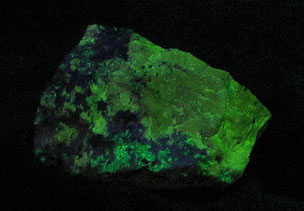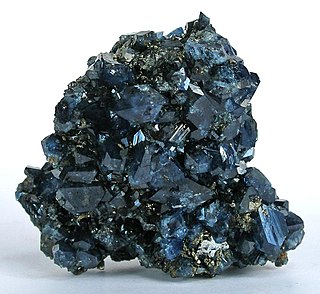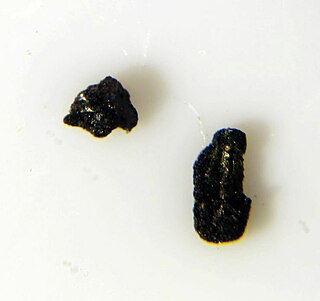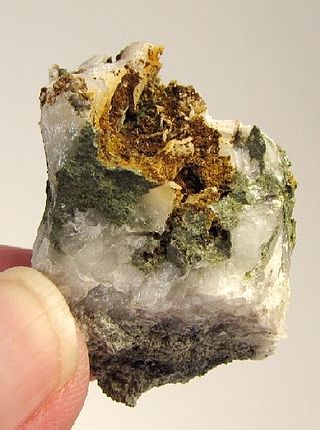
Tephroite is the manganese endmember of the olivine group of nesosilicate minerals with the formula Mn2SiO4. A solid solution series exists between tephroite and its analogues, the group endmembers fayalite and forsterite. Divalent iron or magnesium may readily replace manganese in the olivine crystal structure.

Adamite is a zinc arsenate hydroxide mineral, Zn2AsO4OH. It is a mineral that typically occurs in the oxidized or weathered zone above zinc ore occurrences. Pure adamite is colorless, but usually it possess yellow color due to Fe compounds admixture. Tints of green also occur and are connected with copper substitutions in the mineral structure. Olivenite is a copper arsenate that is isostructural with adamite and there is considerable substitution between zinc and copper resulting in an intermediate called cuproadamite. Zincolivenite is a recently discovered mineral being an intermediate mineral with formula CuZn(AsO4)(OH). Manganese, cobalt, and nickel also substitute in the structure. An analogous zinc phosphate, tarbuttite, is known.

Cotunnite is the natural mineral form of lead(II) chloride (PbCl2). Unlike the pure compound, which is white, cotunnite can be white, yellow, or green. The density of mineral samples spans range 5.3–5.8 g/cm3. The hardness on the Mohs scale is 1.5–2. The crystal structure is orthorhombic dipyramidal and the point group is 2/m 2/m 2/m. Each Pb has a coordination number of 9. Cotunnite occurs near volcanoes: Vesuvius, Italy; Tarapacá, Chile; and Tolbachik, Russia.

Esperite is a rare complex calcium lead zinc silicate (PbCa3Zn4(SiO4)4) related to beryllonite and trimerite that used to be called calcium larsenite. It was named in honor of Esper F. Larsen Jr. (1879–1961), petrologist of Harvard University.

Bournonite is a sulfosalt mineral species, trithioantimoniate of lead and copper with the formula PbCuSbS3.

Enargite is a copper arsenic sulfosalt mineral with formula Cu3AsS4. It takes its name from the Greek word enarge, "distinct". Enargite is a steel gray, blackish gray, to violet black mineral with metallic luster. It forms slender orthorhombic prisms as well as massive aggregates. It has a hardness of 3 and a specific gravity of 4.45.

Scorodite is a common hydrated iron arsenate mineral, with the chemical formula FeAsO4·2H2O. It is found in hydrothermal deposits and as a secondary mineral in gossans worldwide. Scorodite weathers to limonite.

Franckeite, chemical formula Pb5Sn3Sb2S14, belongs to a family of complex sulfide minerals. Franckeite is a sulfosalt. It is closely related to cylindrite.

Stilleite is a selenide mineral, zinc selenide, with the formula ZnSe. It has been found only as microscopic gray crystals occurring as inclusions in linnaeite associated with other selenide and sulfides. It was originally discovered in Katanga Province, Zaire in 1956 and is named for the German geologist, Hans Stille (1876–1966).

Penroseite is a rare selenide mineral with formula (Ni,Co,Cu)Se2. It has a gray-steel color and black streak with a hardness of 3. It is an isometric mineral, 2/m3. Penroseite was first discovered in 1925 in a Bolivian rhyolite. It was named for Richard Penrose (1863–1931), an economic geologist.

Orthorhombic ferroselite and its isometric polymorph dzharkenite are iron selenides of general formula FeSe2 precipitated under reducing conditions in anoxic environments. They are a source of selenium in the Rocky Mountains where selenium occurrence is associated with Upper Cretaceous shale deposits.

Danalite is an iron beryllium silicate sulfide mineral with formula: Fe2+4Be3(SiO4)3S.

Raspite is a mineral, a lead tungstate; with the formula PbWO4. It forms yellow to yellowish brown monoclinic crystals. It is the low temperature monoclinic dimorph of the tetragonal stolzite.

Tyrrellite is a selenide mineral that has a chemical formula of Cu(Co,Ni)2Se4. It has been found in the Goldfields District in northern Saskatchewan, as well as in the Petrovice deposit, Czech Republic. It is named after the Canadian geologist Joseph Burr Tyrrell. Joseph Tyrrell was one of the first geologists from the Geological Survey of Canada to do research in the Goldfields District.

Laurionite is a lead halide mineral. It forms colorless to white crystals in the orthorhombic crystal system and is dimorphous with paralaurionite, both members of the matlockite group.
Chrisstanleyite, Ag2Pd3Se4, is a selenide mineral that crystallizes in high saline, acidic hydrothermal solution at low temperatures as part of selenide vein inclusions in and alongside calcite veins. It tends to be found in assemblages of other selenides: jagueite, naumannite, fischesserite, oosterboschite, and tiemannite, and it is a solid solution mineral with jagueite Cu2Pd3Se4 in which it shares a unique crystal structure that has not been identified elsewhere (Paar et al. 1998; Nickel 2002; Paar et al. 2004). Chrisstanleyite and jagueite are unlike the other minerals of the selenide family as they do not have a sulfide analogue (Topa et al. 2006). First discovered by Werner Paar from a sample received from Hope's Nose, Torquay, Devon, England, chrisstanleyite has since been discovered in the Pilbara region of Western Australia and in El Chire, La Rioja, Argentina. Chrisstanleyite was named after the Deputy Head and Associate Keeper at the Department of Mineralogy at The Natural History Museum in London.

Trogtalite is a rare selenide mineral with the formula CoSe2. It crystallizes in the cubic system and is part of the pyrite group, consisting of Co2+ and Se22− ions. It has a rose-violet colour and its crystals are opaque. It often occurs as grains. It was thought to be dimorphous with hastite, but this was discredited in 2009. Hastite turned out to be the iron selenide mineral ferroselite. It forms a solid solution series with kruťaite.

Berzelianite is a rare copper selenide mineral with the formula Cu2Se. It occurs as thin dendritic crusts or as fine-grained inclusions. It crystallizes in the isometric system, unlike its dimorph, bellidoite, which crystallizes in the tetragonal system. The crystals are opaque and slightly malleable.
Eskebornite is a selenide mineral with the formula CuFeSe2. It crystallizes in the tetragonal system and it has a brassy colour. Eskebornite is sometimes found as thick tabular crystals, but is more often found intergrown with other selenides. It is part of the chalcopyrite group and forms a series with chalcopyrite.

Minrecordite, CaZn(CO3)2, is a very rare mineral belonging to the dolomite group, the member with Ca and Zn. It was discovered, associated with dioptase, in a specimen from the Tsumeb mine (Namibia), which is consequently its type locality. Its name is a tribute to The Mineralogical Record magazine, representing the collaboration between professional and amateur mineralogists. In this locality it is associated primarily with dioptase, and less frequently with duftite, calcite and malachite. It is a rare mineral, which has been found only in a few deposits in the world. In addition to the type locality, it appears in the Preguiça mine, in Moura, district of Beja (Portugal).


















